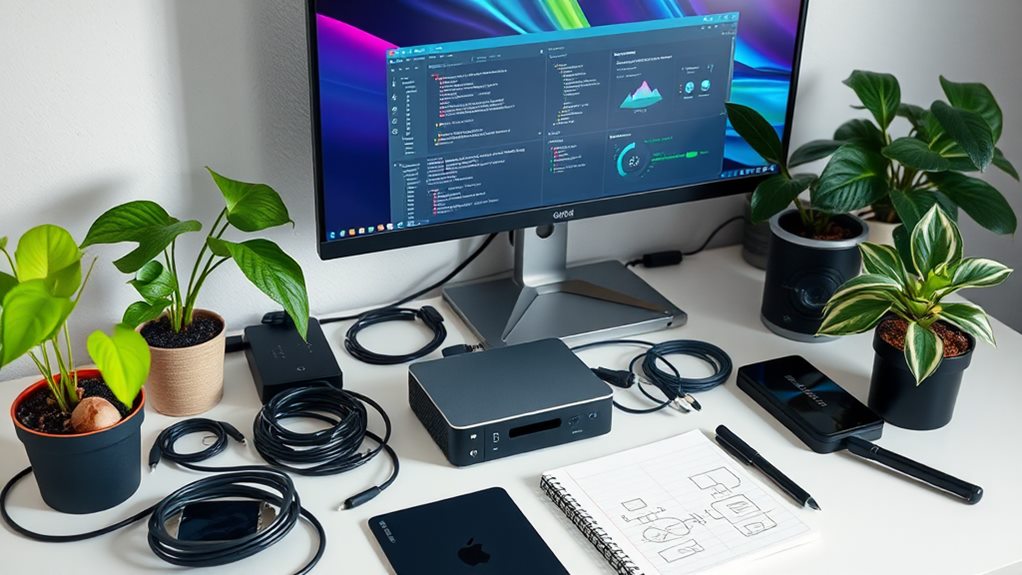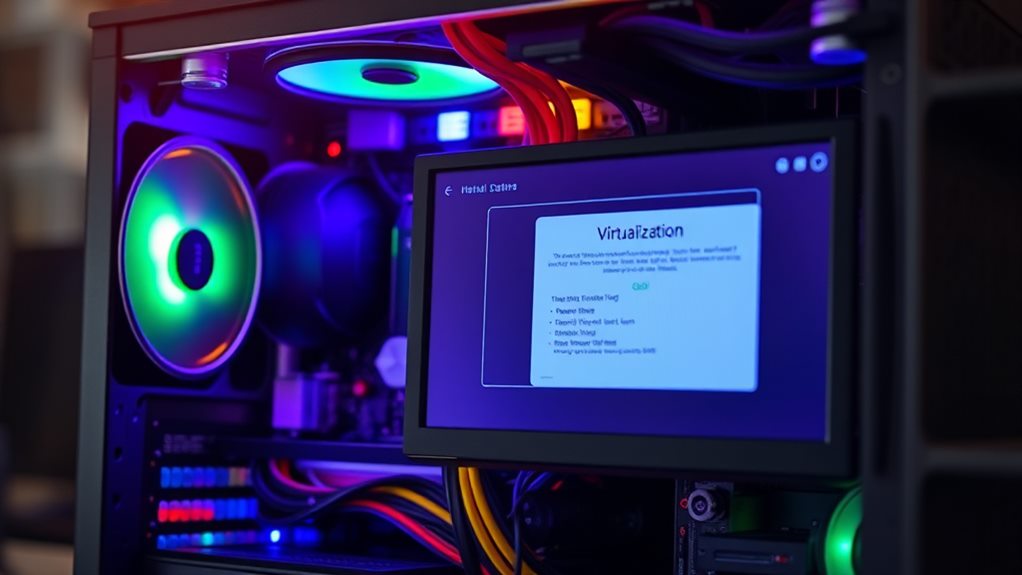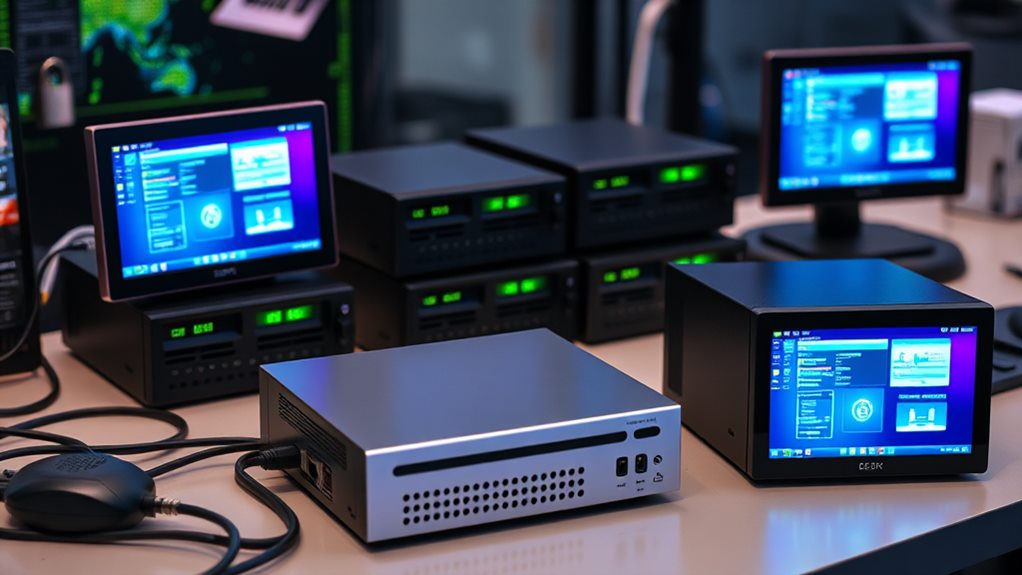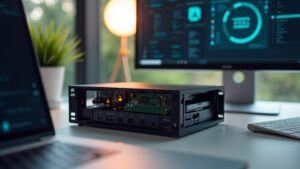To set up virtualization on Mini PCs, start by ensuring your CPU supports Intel VT-x or AMD-V technology. Install a hypervisor like Oracle VM VirtualBox or VMware Workstation, allocating sufficient CPU cores, RAM (at least 8 GB), and SSD storage (100 GB free per VM). Create your VMs using ISO files for the OS, selecting dynamically allocated storage. After installation, install Guest Additions to enhance performance. Regularly update your hypervisor and guest OS for security. Back up your VMs with snapshots and monitor resource usage. As you proceed, you’ll uncover more valuable insights to optimize your setup effectively.
Advantages of Mini PCs

One of the key advantages of Mini PCs is their compact form factor, which makes them perfect for tight spaces. This compact design allows you to fit your Mini PC on desks or mount them on monitors, keeping your workspace uncluttered.
Beyond size, Mini PCs are also energy-efficient, consuming considerably less power than traditional desktops. This efficiency not only reduces operational costs but also aligns with sustainability goals, essential for modern businesses.
Additionally, their flexibility and versatility cater to diverse virtualization needs, from basic testing environments to handling demanding production workloads, making them a solid choice for various applications in virtualization sustainable solutions for virtualization.
For budget-conscious users, Mini PCs generally come at a more affordable price than high-end desktops or server systems, making them an attractive solution, especially for small businesses. Their versatility shines through various configurations that can adapt to your needs—be it for basic testing, set up personal labs, or handle demanding production workloads.
Moreover, many Mini PCs incorporate silent cooling solutions, providing a quiet operation ideal for noise-sensitive environments like home offices or libraries.
This combination of features makes Mini PCs not just practical but also innovative tools in virtualization, capable of fulfilling today’s technological demands. Every aspect of their design caters to the evolving needs of users who seek efficient and powerful performance in a small package.
Key Setup Considerations

Setting up virtualization on Mini PCs requires careful consideration of several technical factors to guarantee peak performance.
First, prioritize CPUs that support Intel VT-x or AMD-V technologies, as these are essential for efficient operation of your virtual machines. Additionally, look for mini-PCs that have enhanced processing power to support complex virtualization tasks, allowing for a more versatile setup.
Next, aim for a minimum of 8 GB of RAM to assure smooth performance, especially when running multiple guest operating systems. For more demanding workloads, consider increasing this capacity.
Storage is another critical aspect; opt for SSD storage due to its superior speed. Make sure there’s at least 100 GB of free space per VM to comfortably accommodate necessary operating systems and applications.
Moreover, consider the benefits of cost-effective solutions that allow users to maximize utility from a single hardware investment.
Additionally, look for Mini PCs that allow for hardware upgrades. This flexibility guarantees your setup remains scalable, enabling enhancements to RAM, storage, or even CPU configurations as your virtualization needs evolve.
Installation and Configuration

When you’re ready to plunge into installation and configuration, start by downloading your preferred hypervisor, such as Oracle VM VirtualBox or VMware Workstation, from its official website. This step is essential as it allows you to harness the potential of your mini PC for various tasks, including enhancing productivity for remote employees.
Follow the installation prompts to complete the setup. Here’s what you need to do next:
- Configure VM Settings: Allocate appropriate CPU cores, RAM, and storage for peak performance.
- Create Virtual Machines (VMs): Through the hypervisor interface, specify the operating systems, RAM, and virtual hard drives for each VM.
- Initiate OS Installation Process: Use ISO files as installation media and follow the on-screen instructions.
During the OS installation, carefully select dynamically allocated storage for your VMs to maximize space usage.
Once you’ve got the OS running, don’t forget to install Guest Additions or appropriate tools for your hypervisor. This enhances interaction between your host and guest operating systems, streamlining performance.
Management and Security

Managing and securing your virtualized environment is essential to maintaining ideal performance and protecting sensitive data. Regularly install updates for your hypervisor and guest operating systems to address security vulnerabilities and enhance system performance. These updates are critical in safeguarding your virtualization setup against potential threats, especially considering the security features of Linux that can provide a robust foundation for your virtual machines.
Implement effective backup strategies by taking regular snapshots of your virtual machines. This guarantees rapid recovery from data loss or system failures, maintaining business continuity in emergencies.
Utilize built-in monitoring tools provided by your hypervisor to keep tabs on resource usage, performance metrics, and the overall health of your virtual machines.
Enforce strict access controls and implement robust security measures, including firewall configurations and antivirus solutions, to create a secure shield around your environment.
It’s fundamental to adhere to industry best practices for compliance, conducting regular audits to confirm that you meet relevant regulations governing data protection.
Future Trends in Virtualization

The landscape of virtualization is rapidly evolving, driven by advancements in hardware capabilities and the increasing demands of modern applications. As you look ahead, consider these emerging trends that will shape the future of virtualization:
- Integration of Edge Computing: More businesses are adopting virtualization technologies to process data closer to the source, enhancing performance and minimizing latency.
- Rise of Cloud-Native Applications and Containerization: The synergy between virtualization and containerization will allow you to deploy applications with unmatched flexibility and scalability.
- Enhanced Automation and Orchestration: Anticipate tools that streamline the management of virtual environments, increasing operational efficiency and reducing manual intervention.
As resource-intensive virtual workloads become the norm, mini PCs will evolve to handle these demands efficiently.
Additionally, as cybersecurity threats escalate, emerging virtualization solutions will incorporate robust security features like isolation and micro-segmentation. This will guarantee better protection for your virtual machines and their data.
Embracing these trends will equip you to leverage virtualization effectively, maximizing performance while addressing the vital need for security in today’s complex digital landscape.
Conclusion
Setting up virtualization on mini PCs opens a domain of possibilities, like opening a door to a digital landscape. By harnessing their compact power, you can streamline your processes and enhance productivity. As you navigate management and security, think of each configuration as a brick in building a fortress against vulnerabilities. Embrace emerging trends, for they represent the wind guiding your sails towards innovation. In this journey, the mini PC becomes not just a tool, but a key to your virtual tomorrow.

I am a retired software engineer with experience in a multitude of areas including managing AWS and VMWare development environments. I bought a relative a mini-PC a year ago and have become passionate about the technology and its potential to change how we deploy software.

